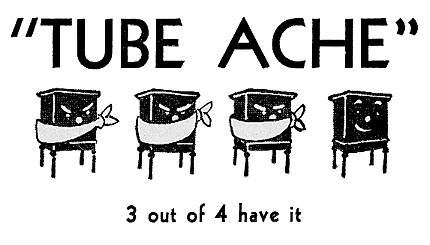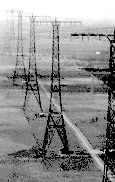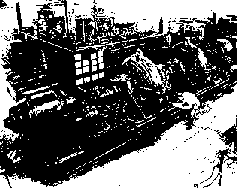![[RCA 806]](images/806.gif)
|
Mister
|

"Yesterday's Technology, Solving Today's Problems, Tomorrow!"
|
Marconi WLW XER/XERA/XERF Farnsworth ENIAC MANIAC |
|

![[RCA 806]](images/806.gif)
|
Mister
|

"Yesterday's Technology, Solving Today's Problems, Tomorrow!"
|
Marconi WLW XER/XERA/XERF Farnsworth ENIAC MANIAC |
|

|
Commercial radio is 100! |
Marconi never claimed to have invented the radio all alone. There were a
number of others working in the field, from Tesla to Nathan B. Stubblefield, all of whom demonstrated communication without wires. These other guys can take a walk, though, for Marconi is the one who put it all together. He demonstrated his first wireless, in Italy, in 1895. He was the world's first ham; a crack engineer and an ace tinkerer, with the managerial smarts to found a gigabuck industry.
Most people associate Marconi with his dramatic test of transatlantic transmission, that gave wireless a permanent commercial role. This didn't happen until 1901. The transmitter, a huge spark coil, was in England, and the receiver, using an antenna held high aloft by a kite, was in Newfoundland. The first signal, sent one way, was a simple 'S' in Morse - three dits. |

|
Marconi's first receivers were coherers, a sort of crystal radio. Early antennas were treated as giant "condensers" (capacitors), with as much wire as was sane to hang as the "aerial" half, and our mother Earth as the ground. At these wavelengths, you couldn't put up too much wire. Radio stations tended to be on rather large plots of land. Marconi, however, soon designed the space-saving antenna that still bears his name, a vertical with counterpoise, often operating at DC ground. Marconi Wireless contracted with many ships, including the Titanic. This doomed vessel's radio call was MGY, the M standing for Marconi. Titanic wasn't the first to use SOS, and in fact sent initial calls with CQD, Marconi's original distress signal. One of the two "Marconi Operators" survived the sinking, and, despite frostbite, insisted on taking his turns at Carpathia's key. Anyone who thinks that news media were any different 80 years ago should look at some of the surviving radiograms - "TALK TO NO ONE X WILL PAY TOP PRICE FOR YOUR STORY AR" was typical! Shoreside, a young Marconi operator named David Sarnoff had just gotten off his shift at the key when he saw headlines of the sinking. He rushed back to the New York station to be of service. Later, when Sarnoff had siezed Marconi Wireless in a Congressional action, and when he had become the owner of mighty RCA, and when he was thus the Bill Gates of his time, he boasted that he'd personally copied Titanic's initial distress call. He hadn't, but nobody argued with him... After this disaster, a series of international treaties created the maritime radio system that, more or less unchanged, saved lives and property until February of 1999. Here we have 80 years of proud service by real radio people, standing 24/7/52 watch at real radios, earning their thunderbolts the hard way. Let's see the GMDSS appliance operators top this record! |

|
The early spark transmitters just blasted, but tuned ones came quickly. They
were huge, hundreds of kW, and they caught fire regularly. Not much later,
General Electric set up a competing wireless network of giant stations using
200 kW Alexanderson alternators. These huge electric generators, spun up
to high RPM, made AC at radio frequencies. There's still a working one in
Sweden, which is fired up a couple of times a year and copied worldwide by those who can receive this low. It is one hellacious device.
Alexanderson might have killed off King Spark all by himself, as Marconi was interested in his alternators, but then there came a new gadget called the radio tube (valve). Early ones came from the world's second ham, Lee de Forest, who never really did understand just why the hell his Audion ever worked at all. De Forest was confused all the way to the bank. |
|

|
Marconi quickly converted to his own, custom, transmitting valves. These were heroic, hand-blown, glass bottles, resembling large chemistry flasks. Wires came out of the ends. To get sufficient output, you hung the required number on a breadboard type of affair, connected the wires to the several bus bars, put in the electrons, and stood clear. Yipe! The wireless was the Internet of its time. It changed everything. No wonder 1995 had a Marconi Centennial.
|
|
14-Year-Old Invents TV in School Electric Shop! |
I'm glad this incredible story is back up on the Web. Philo T. Farnsworth thought up his image dissector , the first electronic TV camera tube, at the age of 14, in rural Utah, in 1922. He went on, more or less, to invent modern television. There's a huge debate about this, not unlike the one over whether Marconi or Tesla invented the wireless. As with Tesla, it's illuminating to look at patent records. While Zworykin got credit for inventing TV with his Iconoscope tube, the image dissector was first with something that actually worked and made pretty pictures. Farnsworth moved to L.A., of all places. Had I been born, I could have warned him that our city sucked the big one, but he found that out for himself. Moving northward, he perfected TV, our century's favorite recreational drug, in a San Francisco factory not far from where a later generation built a city on LSD, receiving a different sort of pictures from nowhere. Getting back to Farnsworth, the suits once again tried to eat the technogeeks for lunch, just as they had done with Tesla, and with Marconi in the U.S.. The great and powerful "General" Sarnoff, as he was calling himself by then, kept TV bottled up in court until RCA could invent its own system. These years of litigation delayed TV's development until Viet Nam was the living room war instead of WW II. So Philo's luck was the luck of all 20th century visionaries, ripped off and dying without recognition, while huge corporations realized enormous wealth from their patents. Farnsworth never gave up, however, continuing research and manufacture of early television gear. Some of this work included innovations in high-power transmitting tubes for VHF and UFH television. However, if current stories are to be believed, Farnsworth may yet have the last laugh. Enter the Fusor, a fairly well documented Farnsworth invention that may very well have achieved practical thermonuclear fusion, something huge research organizations have spent billions of dollars trying to do. While current fusion equipment requires enormous energy and ultra-sophisticated, experimental containers just to achieve a few seconds of sustainable reaction, Farnsworth just possibly did far better with a small laboratory apparatus derived from Mister Valve, or at least from transmitting tube theory. The TV and Fusor stories are both presented in a manner that is downright refreshing on today's ad-driven Web. They are sincere, passionate, and packed with info and pictures of amazing old tube gear. QST should do as well. |
|
U.S. Computing is 56! |
ENIAC stands for Electronic Numerical Integrator And Computer. In WW II, a 'computer' was a person who computed; in this case artillery firing tables for the Army. The computers couldn't compute fast enough. Some guys at UPenn decided that valves could do it faster. They could. ENIAC powered up in 1946, too late for the war, but the Army used it anyway. It also made the first computer weather forecasts. ENIAC wasn't the first computer. The war had other projects requiring massive number-crunching, such as the decryption of intercepted radio messages. The British, at Bletchley Park, had a surprisingly sophisticated, computerlike, device for this purpose. It saved many lives. ENIAC was decimal (used fewer valves, you see), and it had no RAM (not invented yet). It was a transition from calculating machine to computer, as it could not store instructions internally. Even so, computers have had wires instead of neurons ever since. ENIAC led to a whole slew of experimental,electronic computers with names ending in -AC. Foremost of these was Univac, designed by some of the same people when they took their patents into the commercial marketplace. Univac was bought by Remington-Rand, and then by Sperry, and it continued to manufacture and support large mainframes until the 1970s. There were also Illiac, Johnniac (at Rand Corporation), Maniac (Los Alamos), and Silliac (perhaps a commentary on these names). This naming convention carried over into the field of small training machines for hobbyists. Most of these were marketed by Berkeley Enterprises in the 1950s. All were based on the Geniac (Genius Almost-Automatic Computer), an electromechanical contraption using odd rotary switches. This led to Tyniac, Weeniac, and finally to Berkeley's notorious Brainiac (Brain-Imitating Almost-Automatic Computer). Brainiac didn't have much, if any, real computing power, but it apparently had limitless semiotic power, permanently injecting into the mass consciousness the concept of a "Brainiac" for a walking computer (later a nerd or a propellerhead). Brainiac became the name of a TV character, and at least one very entertaining robot-rock band.
Finally came the Minivac 601, from Scientific Development Corporation. This was not a small car vacuum, but instead a rather remarkable breadboard assemblage, about the size of a mixing console, that could be hand-patched to implement various binary and boolean circuits. It used DPDT telephone relays, 6 of 'em, and a single, motor-driven, rotary switch. Minivac did even less than Brainiac, but it was cheap and immortal, and the big, high-current relays made great control interfaces for things. I was given a used one at one point. It made a good Morse code sender, not that much unlike the "CQ wheels" used by commercial stations.
Your calculator/ calendar/ alarm/ thermometer/ phone book watch demonstrates how far computing has come in half a century, but one might also consider the ENIAC-On-A-Chip Project. This was done at UPenn for ENIAC's 50th anniversary. They quite easily reduced the entire room full of machinery to one custom chip which was then placed on an interface board inside a standard PC. Hoist a brew to ENIAC, and people who computed with warm, glass bottles. Cheers, guys! |
![[Picture of neat PA tubes...]](images/mortubes.gif)